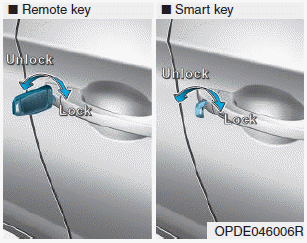Hyundai i-30: Electronic Parking Brake (EPB) / Warning messages
Hyundai i30 (PD) 2018-2025 Owner's Manual / Driving your vehicle / Braking system / Electronic Parking Brake (EPB) / Warning messages

To release EPB, fasten seatbelt, close door, bonnet and tailgate
- If you try to drive with the EPB applied, a warning will sound and a message will appear.
- If the driver's seat belt is unfastened and the engine bonnet or tailgate is opened, a warning will sound and a message will appear.
- If there is a problem with the vehicle, a warning may sound and a message may appear.
If the situation occurs, depress the brake pedal and release EPB by pressing the EPB switch.
WARNING
- Whenever leaving the vehicle or parking, always come to a complete stop and continue to depress the brake pedal. Move the shift lever into the P (Park) position, press the EPB switch, and press the Engine Start/Stop button to the OFF position. Take the Smart Key with you when exiting the vehicle. Vehicles not fully engaged in P (Park) with the parking brake set are at risk for moving inadvertently and causing injury to yourself or others.
- NEVER allow anyone who is unfamiliar with the vehicle to touch the EPB switch. If the EPB is released unintentionally, serious injury may occur.
- Only release the EPB when you are seated inside the vehicle with your foot firmly on the brake pedal.
NOTICE
- Do not apply the accelerator pedal whilst the parking brake is engaged. If you depress the accelerator pedal with the EPB engaged, a warning will sound and a message will appear. Damage to the parking brake may occur.
- Driving with the parking brake on can overheat the braking system and cause premature wear or damage to brake parts. Make sure the EPB is released and the Parking Brake Warning Light is off before driving.
Information
- A clicking sound may be heard whilst operating or releasing the EPB. These conditions are normal and indicate that the EPB is functioning properly.
- When leaving your keys with a parking attendant or assistant, make sure to inform him/her how to operate the EPB.
AUTO HOLD deactivating. Press brake pedal

When the conversion from Auto Hold to EPB is not working properly a warning will sound and a message will appear.
Parking brake automatically locked

If the EPB is applied whilst Auto Hold is activated, a warning will sound and a message will appear.
 Releasing the parking brake
Releasing the parking brake
To release the EPB (Electronic
Parking Brake), press the EPB
switch in the following condition:
Place the Engine Start/Stop button
in the ON position...
 EPB malfunction indicator
EPB malfunction indicator
This warning light illuminates if the
Engine Start/Stop button is changed
to the ON position and goes off in
approximately 3 seconds if the system
is operating normally...
Other information:
Hyundai i30 (PD) 2018-2025 Service Manual: Sub Frame
Repair procedures Removal 1. Loosen the wheel nuts slightly. Raise the vehicle, and make sure it is securelysupported. 2. Remove the front wheel and tire (A) from the fronthub...
Hyundai i30 (PD) 2018-2025 Owner's Manual: ESC OFF usage
When Driving The ESC OFF mode should only be used briefly to help free the vehicle if stuck in snow or mud, by temporarily stopping operation of the ESC, to maintain wheel torque. To turn ESC off whilst driving, press the ESC OFF button whilst driving on a flat road surface...
Categories
- Manuals Home
- 3rd Generation i30 Owners Manual
- 3rd Generation i30 Service Manual
- Engine compartment
- Front windscreen wiper service position
- Battery replacement
- New on site
- Most important about car
Door locks
Operating door locks from outside the vehicle
Mechanical key

Turn the key toward the rear of the vehicle to unlock and toward the front of the vehicle to lock.
If you lock/unlock the driver's door with a key, a driver’s door will lock/unlock automatically.
Copyright © 2025 www.hi30.net
